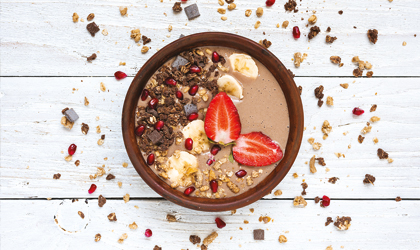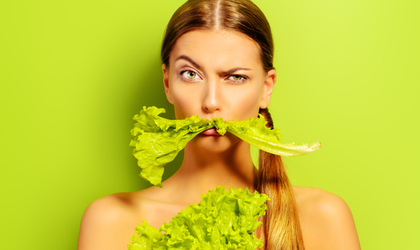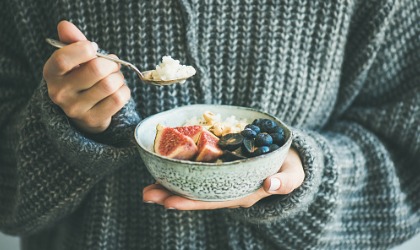
Making the leap to a full-blown plant-powered diet can sound daunting. But with the right approach and resources, it really needn’t be. There’s no one-size-fits-all way to transition. Some people can go cold-turkey (pardon the pun) overnight, while others may need to eliminate meat and dairy gradually. Here are some simple tips to ensure the plant-fuelled swap goes smoothly.
Take small steps
Like any other dietary change, adopting a plant-based lifestyle can take time. Go at your own pace. And don’t be concerned if you need to take it slow. Ultimately, you need to determine the best approach for you. Making small changes to your everyday meals is one of the simplest ways to increase the number of plant foods you pack into your diet. Why not start by having a meat-and dairy-free day a week? Alternatively, try changing one meal at a time: have plant-filled breakfasts on the first week, and then add plant-rich lunches on week two. You could even swap to having oat, coconut or soya milk in your coffee and tea.
Remember why
It can help to remind yourself of the reasons why you decided to pursue plant-forward eating in the first place. If you have a bad day and feel the whole plant-based thing is just too much, take a deep breath and reflect on your choices. If it’s for health reasons, for instance, listening to podcasts, watching informative videos, and reading books can help to remind you of your individual motivations for adopting a plant-powered diet.
Try new things
There’s more to plant-based cuisine than tofu and meat substitutes. In fact, when it comes to plant-powered cooking, the culinary creations are endless. Leaving your comfort zone and trying new foods will take your taste buds on a tantalising voyage of flavours and textures; it will inspire you to use plants in new, delicious ways. If you’re looking for a starting point, Indian, Ethiopian, Greek, and Middle Eastern cuisines are home to some of the most scrumptious plant-centred recipes
Nutritious plant-based swaps
-
Avocado for butter
-
Hummus for mayonnaise
-
Coconut milk for whipped cream
-
Scrambled tofu for scrambled eggs
-
Nutritional yeast for parmesan cheese
-
Oat, hazelnut, cashew, soy or almond milk for dairy milk
-
Combine 1 tbsp chia or flaxseeds with 2.5 tbsp water for eggs
-
Jackfruit for chicken, pork or tuna
-
Bean burgers for beef burgers
-
Tofu or tempeh for meat
-
Lentils for minced meat
Ask for help
You’ll probably have a long list of questions when you decide to kick-start your plant-rich diet. “How do I bake cakes without eggs?” “Where can I buy dairy-free desserts?” “How do I ensure I get enough protein?” You’re not alone. Be sure to reach out to a community – via social media or online – to help make the transition easier. If you’re concerned about how plant-focused eating may affect your social life and dining experiences, there are a number of apps that signpost you to restaurants that cater to plant-based diets. These can be a great addition to your plant-powered arsenal.
What does a healthy plant-based diet look like?
Though your plant-powered diet may be bursting with colourful whole foods and unrefined goodness, chances are, it will also encounter some nutritional shortfalls. “But what could be healthier than an abundance of fruits and vegetables?” you ask. The answer is simple: by excluding major food groups – meat, fish, and dairy – there will be gaps in your nutrient reserves if you don’t carefully plan your food choices. Below, we’ve summarised what a healthy, well-balanced plant-based diet should look like.
Protein
Protein is a vitally important component of every cell in the human body. Structurally speaking, it’s needed for building muscles, bones, and organs. Chemically speaking, it’s essential for making neurotransmitters and hormones. Plant enthusiasts are often quizzed on their protein consumption because many people still equate high-protein foods with meat and fish. In truth, though, there are plenty of plant protein sources available; you just need to be conscientious about the type and amount you consume. Generally, 20-35% of your daily calories should come from plant-protein.
Amount of protein
Plant protein is less bioavailable (not as easily absorbed) than animal protein, so you need to make sure you eat enough on a plant-based diet. The guidelines on protein intake call for a minimum of 0.8g protein per kilogram of weight each day – around 56 grams on average. If you’re active or pregnant, however, you may need more.
Type of protein
Besides quinoa, amaranth, hemp seeds and chia seeds, plant-based protein sources are mostly ‘incomplete’, meaning – unlike fish or meat – they don’t contain enough of the 20 amino acids needed for optimal health. That’s why eating a variety of protein-rich plant-powered foods every week is so essential. This way, you’ll provide your body with the full spectrum of amino acids, ensuring you’re not missing out on key building blocks. You don’t need to hit every nutritional note at each meal; just aim for a healthy, colourful, and diverse week.
Did you know?
The body can’t absorb more than 25 grams of protein in one sitting
Good sources of protein
Beans and legumes
-
Lentils (17.9g)
-
Black beans (15g)?
-
Peas (8.2g)
Vegetables
-
Broccoli (4.2g)
-
Sweet potato (2g)
-
Kale (3g)
-
Brussel sprouts (2g)
Nuts & seeds
-
Hemp seeds (10g)
-
Almonds (7g)
-
Chia (5g)
-
Sesame seeds (5g)
Grains
-
Teff (10g)
-
Quinoa (8g)
-
Oats (6g)
-
Buckwheat (6g)
Superfood powders
-
Maca (3g)
-
Spirulina (2g)
-
Moringa (1g)
-
Matcha (0.5g)
Top tips for boosting protein intake
-
Add a spoonful of nut butter to breakfast – toast and porridge are great canvases
-
Choose natural, whole food sources of protein instead of processed meat substitutes
-
Sprinkle protein-rich seeds (chia and hemp) or nuts on your meals
-
Aim for at least one portion of plant-based protein at each meal (30% of your plate)
The question of soy
Soybeans are often lauded as a good protein source. While this is true, some soy products can be overly refined and processed. If you’re interested in using soy to increase your protein consumption, choose natural sources like Edamame and tempeh. Bonus: these foods are rich in calcium, too!
World-class athletes that follow a plant-based diet, like Venus Williams, Lewis Hamilton, David Haye, Barny du Plessis, and Lionel Messi, are living proof that – contrary to public opinion – vegetables can make you fit, strong, and the epitome of sporting success.
The plant-based plate
When it comes to living a happy, healthy plant-powered lifestyle, balance and variety are key. According to The Vegan Society, a plant-based diet should follow this winning formula.
Food Group
-
Fruit and vegetables (fresh, frozen or dried)
-
Whole grains, like quinoa, oats, brown rice, whole-wheat pasta, and buckwheat
-
Protein-rich foods, such as lentils, chickpeas, and beans
-
Healthy fats, like nuts and seeds – especially those rich in omega 3, such as walnuts, chia seeds, hemp seeds, linseeds, and flaxseeds – avocados and olive oil
-
Calcium-rich foods, such as green leafy vegetables, tofu, tahini, pulses, almonds, and fortified plant-based milk
Suggested Intake
-
At least 5 x 80g portions per day
-
Aim for 3 servings per day eg. 25g oats, 23g uncooked brown rice, 23g uncooked whole wheat pasta.
-
0.8g of protein per kilogram of body weight. Aim for one serving every meal.
-
Aim for the equivalent of a tablespoon of chia seeds or ground linseed, two tablespoons of hemp seeds, or six walnut halves daily.
-
For adults and pregnant women, aim for 800mg per day.
Fibre
The main components of a plant-based diet – whole grains, fruits, vegetables, legumes, nuts, and seeds – are all abundant in fibre. Dietary fibre supports digestion, lowers cholesterol levels, and helps control blood sugar level; it’s indispensable for health and wellbeing. In the UK, the recommended daily intake is 30 grams. But most people only consume 17-20 grams a day. Eating more plant foods is a simple way to boost your fibre intake.
Did you know?
Our ancestors used to eat a whopping 150 grams of dietary fibre each day.
Track your progress
Apps, like ‘Daily Dozen’, can be a useful tool to track your nutritional intake on a plant-focused diet. Following his hit evidence-based book ‘How Not To Die’, Dr Michael Greger created the App ‘Daily Dozen’, which details the healthiest plant-based foods and how many servings of each you should aim to pack into your diet. Far from counting calories, ‘Daily Dozen’ is an innovative way to ensure your nutritional needs are being met on a plant-rich diet. If you want to track your plant-powered food choices, consider downloading an app like this.
Plant-based food on a budget
Critics of the plant-based movement often label it expensive and inaccessible. And while certain speciality plant products are, admittedly, a little pricier (enter expensive dairy-free cheese brands, gourmet mock meats, and organic dairy-free milk) plant-powered nutrition, in principle, should be affordable. Indeed, most store cupboard essentials, like beans, pulses, tinned tomatoes, rice, pasta, potatoes, and fresh or seasonal vegetables, are cheap. even if you weren’t following a plant-centred diet, chances are you’ll be buying these ingredients anyway.
Besides, meat and fish are pretty costly. Apart from alcohol, these items will probably be the most expensive things you buy in your weekly shop. If you were habitually buying organic, free-range joints of meat or wild fish, adopting a plant-based diet will undoubtedly see a decrease in your overall food budget. Plus, the money you’d be saving on meat and fish can go towards paying slightly more for non-dairy milk and other staples. Still, it’s worth knowing the hacks to pack in plants at the best prices possible. Here are our top tips to pinch the pennies on a plant-based diet.
Focus on wholefoods
Wholefoods – that is, foods in their whole form – are some of the most budget-friendly foods on the planet. You can hardly find anything cheaper than beans, rice, oats, lentils, potatoes, and bananas in supermarkets. Beyond saving you a pretty penny, centring your diet on these nourishing foods will benefit your health enormously.
Buy in bulk
Buying in bulk is almost always cheaper. Like frozen food, many store cupboard essentials will keep for a long time, too. Pulses, dried beans, grains, nuts, dried fruit, and oats are healthy staples to stock up on. Our Wholefoods range is a great place to start your bulk buy.
Buy frozen fruit and veggies
Let’s be honest: some fruit and veggies can be pricey. Fortunately, their frozen counterparts are often significantly cheaper! And since these foods are frozen at the peak of their freshness, they can last in your freezer for months. You don’t have to worry about them going off or breaking the bank.
Buy seasonally and locally
The benefits of buying seasonally are numerous. Not only are fruit and veggies at their peak and fresh from harvest – meaning, they’ll taste delicious – but they’re also cheaper because foods in season are in abundance. For instance, figs are exceedingly expensive for the best part of the year. But for a few weeks in autumn, they significantly decrease in price. It also pays to look around farmers markets or greengrocers. Here, you can usually buy seasonal food at more affordable prices. Plus, they’re often fresher, have less packaging, and aren’t flown across the world. Both your wallet and carbon footprint profit!
Avoid products with ‘vegan’ on the label
Speciality plant products are likely to cost you more. If you want to be frugal, limit your intake of mock meats, dairy-free cheese, and luxury nut milk brands. Generally speaking, keep any products advertised as ‘vegan’ to a minimum.
You Might Also Like

Keri
Keri Filtness has worked in the Nutrition Industry for 19 years. She is regularly called upon for her professional comments on health and nutrition related news. Her opinions have been featured by BBC3, Prima, Vitality, The Mirror, Woman’s Own and Cycling Weekly, amongst others. She has also worked one to one with journalists, analysing their diets and health concerns and recommending changes and additions, where appropriate.
View More



